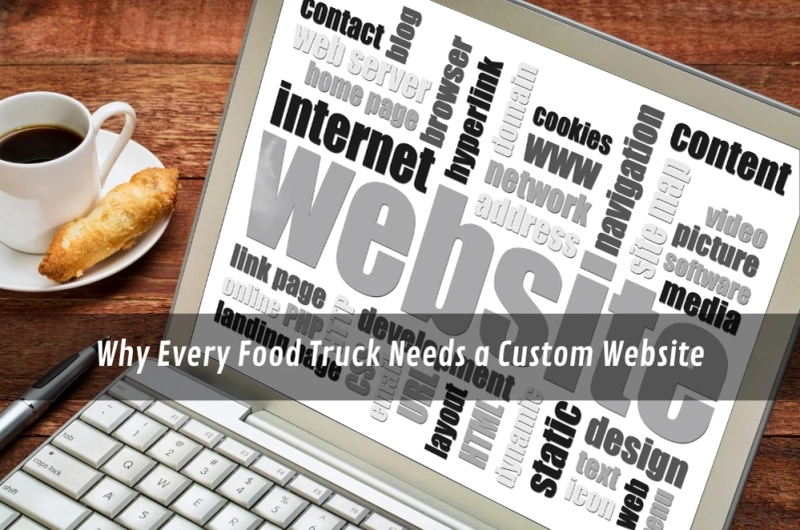When a mate launched his food truck a while back, we expected the usual challenges — council permits, long prep hours, unpredictable weather. What caught us off guard was how much the website mattered. People were looking him up online, checking where he’d be, what he served, and how to book him — all before even trying the food.
We hadn’t planned for it, but having a proper food truck website design gave his business a kind of stability that social media alone couldn’t. It answered questions before they were asked, saved time on messaging, and helped people find him without the back-and-forth.
In a business where your location changes daily, having a fixed digital presence becomes one of the few things customers can count on. And sometimes, that’s what gets them to line up before you’ve even turned on the grill.
What a modern food truck website needs to deliver
Most people think of a food truck site as a menu slapped online. But a proper one? It does much more. A good website actively supports how you operate. It should anticipate questions before they're asked.
Some key features that make a difference:
- Live schedule with your current and upcoming locations
- Simple, mobile-friendly layout that looks good on any phone
- Clear menu section — not just items, but details like allergens
- Easy enquiry or booking form for private events
- Smooth navigation that doesn't confuse your visitors
I’ve seen setups where a website saved time every single day. Instead of replying to messages like “Where are you today?”, the truck could just point people to the schedule page. Instead of fielding calls, they’d receive enquiry emails. When built thoughtfully, a food truck website can work as a digital assistant — one that’s on duty 24/7.
How a website reinforces trust through best practices
People care where their food comes from. They care who’s handling it. And even though a food truck is a fun, street-level experience, it still benefits from an image of reliability. Trust can be built long before the customer tastes a single bite.
A well-built website shows that you take the operation seriously. Beyond design and branding, it’s also about structure. Following website best practice guidelines — from accessibility to usability — can quietly signal that your business is run properly behind the scenes, too.
Think about a customer deciding between two trucks for their corporate lunch. One has a broken site. The other loads quickly, has clear details, and works on mobile. They’ll pick the second every time — not because the food is guaranteed better, but because the presentation shows care.
Beyond the basics: design tips from other mobile businesses
Not all design ideas come from within the food world. Some of the best insights I’ve seen came from industries you wouldn’t expect. One site I worked on for a distribution company stuck with me — not because of what they sold, but how they presented it.
Their layout prioritised movement, clarity, and speed. It wasn’t full of fluff. It simply helped people get what they needed, fast. That sort of thinking applies beautifully to food trucks.
Some ideas worth borrowing:
- Make sure your call-to-action buttons are easy to find and clearly worded
- Avoid overwhelming visitors with too many choices up front
- Use visual hierarchy — bigger headings, bold dish names, contrast between sections
- Keep your brand consistent — from truck wrap to website font
- Don’t bury your location or hours — make them obvious
Plenty of the structure and tone I saw in modern web design tips translates smoothly to mobile food operators. It’s not about copying the aesthetic — it’s about applying the thought process: build for clarity, not just for looks.
Standing out with storytelling and strategy
Food trucks often start with passion. Maybe it’s a family recipe, a dream to be independent, or a love for a particular cuisine. That story? It matters. And when done right, your website is the perfect place to tell it — without making it feel forced.
The best sites I’ve worked on had a real voice. They didn’t sound like they were written by a committee. They shared how the menu came together, what inspired the business, or even how the name of the truck was chosen. Little bits of storytelling make a big impact.
This approach doesn't just make your site more enjoyable — it can help the site perform better too. Visitors stay longer when there’s something genuine to read. They connect with it. And the more connections there are, the more likely they are to come back. I’ve seen it in real time.
One approach that aligns nicely with this is understanding how strategic website ROI plays out — not just through sales but through increased trust, better event bookings, and smoother communication. When your digital presence is aligned with who you are and what you do, the results come quietly, but steadily.

Final thoughts: let your digital presence keep up with your wheels
Food trucks are made to move — that’s the whole appeal. But movement shouldn’t mean instability when it comes to your brand. If your schedule changes every week, your customers need a place to land. A website gives them that.
It doesn’t have to be complex. It just has to be well thought out. Clear menus, an easy contact path, and a bit of personality can do more for your truck than you think. In fact, it might be the difference between being remembered and being missed.
That’s the quiet power of having a home online. It keeps your business grounded, even when the wheels are turning.



